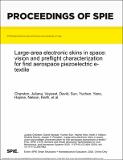| dc.contributor.author | Cherston, Juliana Mae | |
| dc.contributor.author | Veysset, David Georges | |
| dc.contributor.author | Sun, Yuchen | |
| dc.contributor.author | Yano, Hajime | |
| dc.contributor.author | Nelson, Keith Adam | |
| dc.contributor.author | Murari, Shobha | |
| dc.contributor.author | Paradiso, Joseph A | |
| dc.date.accessioned | 2020-11-25T22:46:44Z | |
| dc.date.available | 2020-11-25T22:46:44Z | |
| dc.date.issued | 2020-04 | |
| dc.identifier.isbn | 9781510635357 | |
| dc.identifier.isbn | 9781510635364 | |
| dc.identifier.uri | https://hdl.handle.net/1721.1/128667 | |
| dc.description.abstract | Aerospace-grade textiles have decades of flight heritage for protection against harsh elements of the space environment. However, these substrates have remained electrically passive despite occupying useful large-area real-estate on the exterior walls of persistent spacecraft. By leveraging electronic textiles in an aerospace context, hybrid fabrics can be developed that simultaneously protect spacecraft while also detecting debris or micrometeoroid hypervelocity impactors. Specifically, this paper describes prototype development and preflight testing of piezoelectric Beta cloth ahead of a scheduled late 2020 material resiliency test on the International Space Station. Two accessible manufacturing methods for piezoelectric fiber are introduced based on modifications to piezoelectric cable that reduce diameter, increase mechanical flexibility of the fiber, and improve compatibility with textile weft insertion techniques. A Beta cloth simulant with piezoelectric fiber is introduced and custom ultra low power readout electronics are specified, which allow for a first-order power consumption estimate for scaling of this material across large-area spacecraft walls. Finally, high-velocity impact sensor data measured using the Laser Induced Particle Impact Test (LIPIT) facility is presented, building towards an accurate prediction of impactor velocity. | en_US |
| dc.language.iso | en | |
| dc.publisher | SPIE | en_US |
| dc.relation.isversionof | http://dx.doi.org/10.1117/12.2557942 | en_US |
| dc.rights | Article is made available in accordance with the publisher's policy and may be subject to US copyright law. Please refer to the publisher's site for terms of use. | en_US |
| dc.source | SPIE | en_US |
| dc.title | Large-area electronic skins in space: vision and preflight characterization for first aerospace piezoelectric e-textile | en_US |
| dc.type | Article | en_US |
| dc.identifier.citation | Cherston, Juliana et al. "Large-area electronic skins in space: vision and preflight characterization for first aerospace piezoelectric e-textile." Proceedings of SPIE 11379 (April 2020): 113791Q © 2020 SPIE | en_US |
| dc.contributor.department | Massachusetts Institute of Technology. Media Laboratory | en_US |
| dc.contributor.department | Massachusetts Institute of Technology. Department of Chemistry | en_US |
| dc.contributor.department | Massachusetts Institute of Technology. Institute for Soldier Nanotechnologies | en_US |
| dc.relation.journal | Proceedings of SPIE | en_US |
| dc.eprint.version | Final published version | en_US |
| dc.type.uri | http://purl.org/eprint/type/ConferencePaper | en_US |
| eprint.status | http://purl.org/eprint/status/NonPeerReviewed | en_US |
| dc.date.updated | 2020-09-18T15:31:59Z | |
| dspace.date.submission | 2020-09-18T15:32:07Z | |
| mit.journal.volume | 11379 | en_US |
| mit.license | PUBLISHER_POLICY | |
| mit.metadata.status | Complete | |
